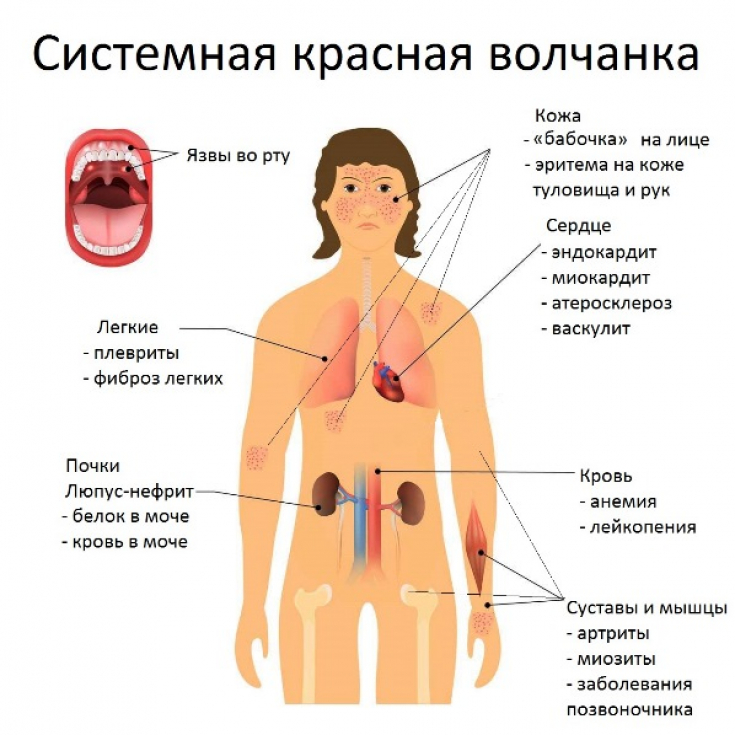Systemic lupus erythematosus is an autoimmune disease that predominantly affects women and is characterized by clinical diversity and a complex set of immunological abnormalities.
In the pathogenesis of systemic lupus erythematosus, a key place is occupied by the production of autologous antibodies directed against the nuclei of the body's own cellular structures.
For more details about modern diagnostics of systemic lupus erythematosus, as well as the principles of treatment of the disease that meet international recommendations, read on estet-portal.com in this article.
Systemic lupus erythematosus: modern aspects of the epidemiology of the disease
The prevalence of systemic lupus erythematosus worldwide is, according to various sources, from 4 to 250 per 100,000 people. About 90% of patients – women.
Approximately half of the cases of systemic lupus erythematosus are diagnosed in patients under 30 years of age. About 15% of patients develop systemic lupus erythematosus in childhood (mostly between the ages of 12 and 14).
Systemic lupus erythematosus is characterized by a wide variety of clinical manifestations. Initial symptoms may develop either suddenly or slowly, and the disease may have either a continuously progressive or relapsing course.
Follow us on Facebook
Systemic lupus erythematosus: modern diagnostic criteria for the disease
For the diagnosis of systemic lupus erythematosus, international protocols recommend using the 2012 Classification criteria for SLE 2012.
The diagnosis of systemic lupus erythematosus is established by the presence of 4 of the 17 criteria listed below. Moreover, at least one of these 4 criteria is clinical and one – immunologic, or the patient has biopsy-proven nephritis consistent with the presence of ANA (antinuclear antibodies) or anti-dsDNA antibodies.
Criteria for diagnosing systemic lupus erythematosus include:
1. Acute skin lesions (photosensitivity, bullous eruptions, rash on the cheekbones, maculopapular rash, toxic epidermal necrosis);
2. Chronic skin lesions (discoid rash, panniculitis, capillaritis, hypertrophic skin lesions, discoid lupus erythematosus like lichen planus or overlap);3. Ulcerative lesions of the mucous membranes;
4. Non-scarring alopecia;
5. Synovitis involving two or more joints;
6. Serositis (pleurisy or pericarditis);
7. Nephritis (proteinuria exceeds 500 mg/day);
8. Neurological symptoms (convulsions, psychosis, myelitis, peripheral or cranial neuropathy);
9. Hemolytic anemia;
10. Leukopenia or lymphopenia (value less than 4 x 109 and 1 x 109 respectively);

1. Anti-dsDNA antibodies;
2. Anti-Sm antibodies;
3. ANA (antinuclear antibodies);
4.
5. Low compliment (C3, C4 or CH50)
6. Positive direct Coombs test in the absence of hemolytic anemia; Read more about modern aspects of the treatment of systemic lupus erythematosus in the article.
Self-Destructive Mechanism: What Happens in Systemic Lupus Erythematosus Modern principles of treatment of systemic lupus erythematosus
Treatment of systemic lupus erythematosus is aimed at relieving the symptoms of the disease, controlling the active disease phase, preventing exacerbations, minimizing drug side effects, and improving the patient's quality of life and prognosis.
All patients with systemic lupus erythematosus should avoid environmental triggers, including exposure to sunlight, physical and mental exhaustion, and sulfonamides.
Treatment of systemic lupus erythematosus is individualized and based on the characteristics of the clinical picture of the disease in each individual case.
Drug treatment for mild systemic lupus erythematosus
According to international protocols (EBM Guidelines «Systemic lupus erythematosus»), treatment of mild systemic lupus erythematosus is the use of non-steroidal anti-inflammatory drugs (NSAIDs), hydroxychloroquine (average 300 mg/day), glucocorticoids (5-10 mg prednisolone/day) and methotrexate (10-25 mg once a week).
If there is pleurisy and pericarditis in the clinical picture of systemic lupus erythematosus, treatment begins with a higher dose of glucocorticoids (prednisolone 20-40 mg / day).
The role of antinuclear antibodies in the pathogenesis of systemic lupus erythematosus Aspects of pharmacotherapy for severe systemic lupus erythematosus
Severe systemic lupus erythematosus is characterized by the presence of nephritis, pneumonitis, carditis, CNS damage and changes in the blood picture. According to the EBM Guidelines "Systemic lupus erythematosus", the drugs of choice are:
1. High doses of glucocorticoids (initial doses are at least 40-60 mg of prednisolone per day);
2. Azathioprine 2-2.5 mg/kg/day (as maintenance therapy for mild nephritis);
3. Cyclosporine 2-4 mg/kg/day (indication: membranous glomerulonephritis);
4. Mycophenolate 1500-3000 mg/day (drug of choice for severe focal or diffuse glomerulonephritis);
5. Cyclophosphamide 1-2 mg/kg/day (indications are severe focal or diffuse glomerulonephritis, other life-threatening complications);
6. Hydroxychloroquine (lowers blood lipids and prevents vascular occlusion).
In cases of severe systemic lupus erythematosus, when standard treatment regimens are not effective enough, international protocols recommend the use of rituximab and belimumab.
Thank you for staying with estet-portal.com. Read other interesting articles in the "Dermatology" section. You may also be interested in
Systemic Lupus Erythematosus: Why Early Treatment Matters







Add a comment